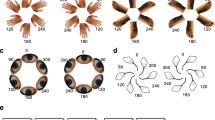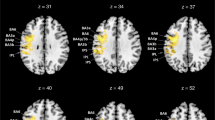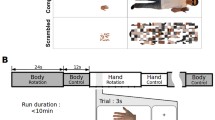Abstract
Normally, we are aware that our arms and legs belong to us and not to someone else. However, some stroke patients with hemiparesis/-plegia after right-sided stroke show a disturbed sensation of limb ownership and a disturbed self-awareness of actions and such patients with anosognosia for hemiparesis/plegia typically deny their paresis/-plegia and are convinced that their limbs function normally. They may experience their limb(s) as not belonging to them and may even attribute them to other persons. Modern lesion analyses techniques in such patients and recent neuroimaging results in healthy subjects suggest a prominent role of the right insula for our sense of limb ownership as well as for our feeling of being involved in a movement—our sense of agency. We thus hypothesize that the right insular cortex constitutes a central node of a network involved in human body scheme representation.

Similar content being viewed by others
References
André JM, Martinet N, Paysant J, Beis JM, Le Chapelain L (2001) Temporary phantom limbs evoked by vestibular caloric stimulation in amputees. Neuropsychiatry Neuropsychol Behav Neurol 14:190–196
Appelros P, Karlsson GM, Seiger A, Nydevik I (2002) Neglect and anosognosia after firstever stroke: incidence and relationship to disability. J Rehabil Med 34:215–220
Augustine JR (1996) Circuitry and functional aspects of the insular lobe in primates including humans. Brain Res Rev 22:229–244
Baier B, Karnath HO (2005) Incidence and diagnosis of anosognosia for hemiparesis. J Neurol Neurosurg Psychiatry 76:358–361
Baier B, Karnath HO (2008) Tight link between our sense of limb ownership and self-awareness of actions. Stroke 39:486–488
Baier B, Bense S, Birklein F, Buchholz HG, Mischke A, Schreckenberger M, Dieterich M (2010) Evidence for modulation of opioidergic activity in central vestibular processing: A [18F] diprenorphine PET study. Hum Brain Mapp 31:550–555
Bense S, Bartenstein P, Lochmann M, Schlindwein P, Brandt T, Dieterich M (2004) Metabolic changes in vestibular and visual cortices in acute vestibular neuritis. Ann Neurol 56:624–630
Berti A, Bottini G, Gandola M, Pia L, Smania N, Stracciari A, Castiglioni I, Vallar G, Paulesu E (2005) Shared cortical anatomy for motor awareness and motor control. Science 309:488–491
Bisiach E, Rusconi ML, Vallar G (1991) Remission of somatoparaphrenic delusion through vestibular stimulation. Neuropsychologia 29:1029–1031
Blanke O, Landis T, Spinelli L, Seeck M (2004) Out-of-body experience and autoscopy of neurological origin. Brain 127:243–258
Bottini G, Sterzi R, Paulesu E, Vallar G, Cappa SF, Erminio F, Passingham RE, Frith CD, Frackowiak RS (1994) Identification of the central vestibular projections in man: a positron emission tomography activation study. Exp Brain Res 99:164–169
Bottini G, Karnath HO, Vallar G, Sterzi R, Frith CD, Frackowiak RS, Paulesu E (2001) Cerebral representations for egocentric space: functional-anatomical evidence from caloric vestibular stimulation and neck vibration. Brain 124:1182–1196
Botvinick M (2004) Probing the neural basis of body ownership. Science 305:782–783
Botvinick M, Cohen J (1998) Rubber hands “feel” touch that eyes see. Nature 391:756
Brandt T, Dieterich M, Danek A (1994) Vestibular cortex lesions affect the perception of verticality. Ann Neurol 35:403–412
Breier Jl, Adair JC, Gold M, Fennell EB, Gilmore RL, Heilman KM (1995) Dissociation of anosognosia for hemiplegia and aphasia during left-hemisphere anesthesia. Neurology 45:65–67
Brooks JC, Nurmikko TJ, Bimson WE, Singh KD, Roberts N (2002) fMRI of thermal pain: effects of stimulus laterality and attention. Neuroimage 15:293–301
Cappa S, Sterzi R, Vallar G, Bisiach E (1987) Remission of hemineglect and anosognosia during vestibular stimulation. Neuropsychologia 25:775–783
Cereda C, Ghika J, Maeder P, Bogousslavsky J (2002) Strokes restricted to the insular cortex. Neurology 59:1950–1955
Cocchini G, Beschin N, Cameron A, Fotopoulou A, Della Sala S (2009) Anosognosia for motor impairment following left brain damage. Neuropsychology 23:223–230
Contreras M, Ceric F, Torrealba F (2007) Inactivation of the interoceptive insula disrupts drug craving and malaise induced by lithium. Science 318:655–658
Corradi-Dell’ Acqua C, Ueno K, Ogawa A, Cheng K, Rumiata RI, Iriki A (2008) Effects of shifting perspective of the self: an fMRI study. Neuroimage 40:1902–1911
Craig AD (2002) How do you feel? Interoception: the sense of physiological condition of the body. Nat Rev Neurosci 3:655–666
Craig AD (2009) How do you feel-now? The anterior insula and human awareness. Nat Rev Neurosci 10:59–70
Craig AD (2010) The insular cortex and subjective feeling states. In: Prigatano GP (ed) The study of anosognosia. Oxford University Press, Oxford
Craig AD, Reiman EM, Evans A, MCl Bushnell (1996) Functional imaging of an illusion of pain. Nature 384:258–260
Craig AD, Chen K, Bandy D, Reiman EM (2000) Thermosensory activation of insular cortex. Nat Neurosci 3:184–190
Cutting J (1978) Study of anosognosia. J Neurol Neurosurg Psychiatry 41:548–555
Damasio AR, Grabowski TJ, Bechara A, Damasio H, Ponto LLB, Parvizi J, Hichwa RD (2000) Subcortical and cortical brain activity during the feeling of self-generated emotions. Nat Neurosci 3:1049–1056
Devue C, Collette F, Balteau E, Degueldre C, Luxen A, Maquet P, Brédart S (2007) Here I am: the cortical correlates of visual self-recognition. Brain Res 1143:169–182
Dieterich M, Brandt T (2008) Functional brain imaging of peripheral and central vestibular disorders. Brain 131:2538–2552
Dronkers NF (1996) A new brain region for coordinating speech articulation. Nature 384:159–161
Ehrsson HH, Wiech K, Weiskopf N, Dolan RJ, Passingham RE (2007) Threatening a rubber hand that you feel is yours elicits a cortical anxiety response. Proc Natl Acad Sci USA 104:9828–9833
Eickhoff SB, Weiss PH, Amunts K, Fink GR, Zilles K (2006) Identifying human parieto-insular vestibular cortex using fMRI and cytoarchitectonic mapping. Hum Brain Mapp 27:611–621
Emri M, Kisely M, Lengyel Z, Balkay L, Márián T, Mikó L, Berényi E, Sziklai I, Trón L, Tóth A (2003) Cortical projection of peripheral vestibular signaling. J Neurophysiol 89:2639–2646
Farrell MJ, Egan GF, Zamarripa F, Shade R, Blair-West J, Fox P, Denton DA (2006) Unique, common, and interacting cortical correlates of thirst and pain. Proc Natl Acad Sci USA 103:2416–2421
Farrer C, Franck N, Georgieff N, Frith CD, Decety J, Jeannerod M (2003) Modulating the experience of agency: a positron emission tomography study. Neuroimage 18:324–333
Farrer C, Franck N, Frith CD, Decety J, Georgieff N, d’Amato T, Jeannerod M (2004) Neural correlates of action attribution in schizophrenia. Psychiatry Res 131:31–44
Farrer C, Frey SH, Van Horn JD, Tunik E, Turk D, Inati S, Grafton ST (2008) The angular gyrus computes action awareness representations. Cereb Cortex 18:254–261
Faurion A, Cerf B, Le Bihan D, Pillias A-M (1998) fMRI study of taste cortical areas in humans. Ann N Y Acad Sci 855:535–545
Felician O, Anton JL, Nazarian B, Roth M, Roll JP, Romaiguère P (2009) Where is your shoulder? Neural correlates of localizing others’ body parts. Neuropsychologia 47:1909–1916
Fiol ME, Leppick IE, Mireles R, Maxwell R (1988) Ictus emeticus and the insular cortex. Epilepsy Res 2:127–131
Frot M, Mauguière F (2003) Dual representation of pain in the operculo-insular cortex in humans. Brain 126:438–450
Gilmore RL, Heilman KM, Schmidt RP, Fennell EM, Quisling R (1992) Anosognosia during Wada testing. Neurology 42:925–927
Griffiths D, Tadic SD, Schaefer W, Resnick NM (2007) Cerebral control of the bladder in normal and urge-incontinent women. Neuroimage 37:1–7
Humbert IA, Robbins J (2007) Normal swallowing and functional magnetic resonance imaging: a systematic review. Dysphagia 22:266–275
Karnath HO (2009) A right perisylvian neural network for human spatial orienting. In: Gazzaniga MS (ed) The cognitive neurosciences IV. MIT Press, Cambridge, pp 259–268
Karnath HO, Baier B (2010) Anosognosia for hemiparesis and hemiplegia: disturbed sense of agency and body ownership. In: Prigatano GP (ed) The study of anosognosia. Oxford University Press, Oxford
Karnath HO, Ferber S, Himmelbach M (2001) Spatial awareness is a function of the temporal not the posterior parietal lobe. Nature 411:950–953
Karnath HO, Fruhmann Berger M, Küker W, Rorden C (2004) The anatomy of spatial neglect based on voxelwise statistical analysis: a study of 140 patients. Cereb Cortex 14:1164–1172
Karnath HO, Baier B, Nägele T (2005) Awareness of the functioning of one’s own limbs mediated by the insular cortex? J Neurosci 25:7134–7138
Kimmerly DS, O’Leary DD, Menon RS, Gati JS, Shoemaker JK (2005) Cortical regions associated with autonomic cardiovascular regulation during lower body negative pressure in humans. J Physiol 569:331–345
Kong J, White NS, Kwong KK, Vangel MG, Rosman IS, Gracely RH, Gollub RL (2006) Using fMRI to dissociate sensory encoding from cognitive evaluation of heat pain intensity. Hum Brain Mapp 27:715–721
Lopez C, Halje P, Blanke O (2008) Body ownership and embodiment: vestibular and multisensory mechanisms. Neurophysiol Clin 38:149–161
Maihöfner C, Kaltenhäuser M, Neundörfer B, Lang E (2002) Temporo-spatial analysis of cortical activation by phasic innocuous and noxious cold stimuli—a magnetoencephalographic study. Pain 100:281–290
Mesulam MM, Mufson EJ (1985) The insula of reil in man and monkey. Architectonics, connectivity, and function. In: Peters A, Jones EG (eds) Cerebral cortex. Plenum Press, New York, pp 179–226
Moseley GL, Olthof N, Venema A, Don S, Wijers M, Gallace A, Spence C (2008) Psychologically induced cooling of a specific body part caused by the illusory ownership of an artificial counterpart. Proc Natl Acad Sci USA 105:13169–13173
Naqvi NH, Rudrauf D, Damasio H, Bechara A (2007) Damage to the insula disrupts addiction to cigarette smoking. Science 315:531–534
Nathanson M, Bergman P, Gordon G (1952) Denial of illness. Its occurrence in one hundred consecutive cases of hemiplegia. Arch Neurol Psychiatry 68:380–387
Ogawa H, Wakita M, Hasegawa K, Kobayakawa T, Sakai N, Hirai T, Yamashita Y, Saito S (2005) Functional MRI detection of activation in the primary gustatory cortices in humans. Chem Senses 30:583–592
Paulus MP, Stein MB (2006) An insular view of anxiety. Biol Psychiatry 60:383–387
Phillips ML, Young AW, Senior C, Brammer M, Andrew C, Calder AJ, Bullmore ET, Perrett DI, Rowland D, Williams SCR, Gray JA, David AS (1997) A specific neural substrate for perceiving facial expressions of disgust. Nature 389:495–498
Rode G, Charles N, Perenin MT, Vighetto A, Trillet M, Aimard G (1992) Partial remission of hemiplegia and somatoparaphrenia through vestibular stimulation in a case of unilateral neglect. Cortex 28:203–208
Rorden C, Karnath HO (2004) Using human brain lesions to infer function: a relic from a past era in the fMRI age? Nat Rev Neurosci 5:813–819
Rorden C, Karnath HO, Bonilha L (2007) Improving lesion-symptom mapping. J Cogn Neurosci 19:1081–1088
Rorden C, Fridriksson J, Karnath HO (2009) An evaluation of traditional and novel tools for lesion behavior mapping. Neuroimage 44:1355–1362
Sang FY, Jáuregui-Renaud K, Green DA, Bronstein AM, Gresty MA (2006) Depersonalisation/derealisation symptoms in vestibular disease. J Neurol Neurosurg Psychiatry 77:760–766
Schneider RC, Calhoun HD, Kooi KA (1971) Circling and rotational automatisms in patients with frontotemporal cortical and subcortical lesions. J Neurosurg 35:554–563
Schneider RJ, Friedman DP, Mishkin M (1993) A modality-specific somatosensory area within the insula of the rhesus monkey. Brain Res 621:116–120
Schreckenberger M, Siessmeier T, Viertmann A, Landvogt C, Buchholz HG, Rolke R, Treede RD, Bartenstein P, Birklein F (2005) The unpleasantness of tonic pain is encoded by the insular cortex. Neurology 64:1175–1183
Showers MJC, Laucer EW (1961) Somatovisceral motor patterns in the insula. J Comp Neurol 117:107–115
Starkstein SE, Fedoroff JP, Price TR, Leiguarda R, Robinson RG (1992) Anosognosia in patients with cerebrovascular lesions. Stroke 23:1446–1453
Stein MB, Simmons AN, Feinstein JS, Paulus MP (2007) Increased amygdala and insula activation during emotion processing in anxiety-prone subjects. Am J Psychiatry 164:318–327
Sugar O, Chusid JG, French JD (1948) A second motor cortex in the monkey (Macaca mulatta). J Neuropathol Exp Neurol 7:182–189
Tsakiris A, Hesse MD, Boy C, Haggard P, Fink GR (2007) Neural signatures of body ownership: a sensory network for bodily self-consciousness. Cereb Cortex 17:2235–2244
Vocat R, Vuilleumier P (2010) Neuroanatomy of impaired body awareness in anosognosia and hysteria: a multi-component account. In: Prigatano GP (ed) The study of anosognosia. Oxford University Press, Oxford
Acknowledgments
This work was supported by the Bundesministerium für Bildung und Forschung (BMBF-Verbundprojekt “Räumliche Orientierung” 01GW0641) and the Deutsche Forschungsgemeinschaft (KA 1258/10-1).
Author information
Authors and Affiliations
Corresponding author
Rights and permissions
About this article
Cite this article
Karnath, HO., Baier, B. Right insula for our sense of limb ownership and self-awareness of actions. Brain Struct Funct 214, 411–417 (2010). https://doi.org/10.1007/s00429-010-0250-4
Received:
Revised:
Accepted:
Published:
Issue Date:
DOI: https://doi.org/10.1007/s00429-010-0250-4




